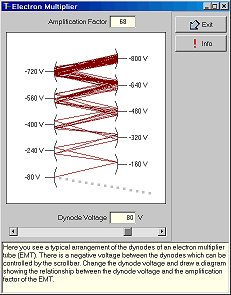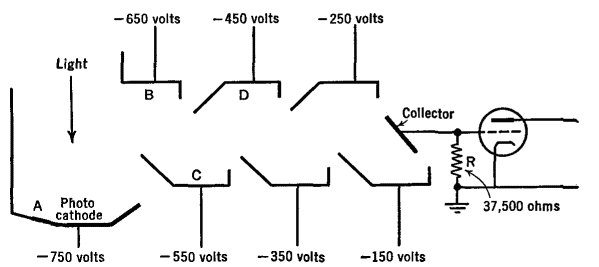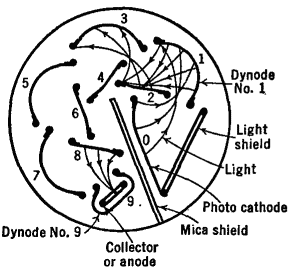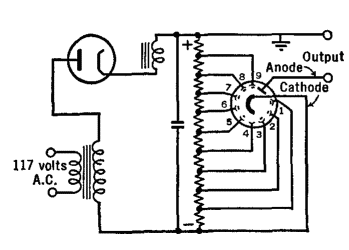| Basic Radio is a free introductory textbook on electronics based on tubes. See the editorial for more information.... |

|

Home  Electronic Devices Electronic Devices  Photoelectric Cells Photoelectric Cells  Photo-Multiplier Tubes Photo-Multiplier Tubes |
|||||||||||||
| See also: Some Electron Multiplier Tubes | |||||||||||||






|
|||||||||||||
|
Photo-Multiplier TubesAuthor: J.B. Hoag The phenomenon of secondary emission was discussed earlier and the nature of "voltage" multiplier tubes was presented in Sec. 15.5.
As an example of the sensitivity of a multiplier, the output may be 40 milliamperes per lumen with 100 volts per stage. At a light level varying from zero to 0.05 lumen, the collector current would then change from zero to 2 milliamperes. The chief advantage of photo-multiplier tubes lies in their ability to detect and measure very weak light intensities. With an ordinary phototube, the erratic "dark current" or no-light current is often so great as to mask any current set up by a small amount of light sent onto the cathode.
Figure 20 M shows the structure of a 9-stage electrostatically-focused multiplier phototube. When adjusted so that 5 secondaries appear for each incident electron, the current amplification would be, theoretically, 59 or approximately 2 million. The dark current is equivalent to that produced by about 10-6 lumen; in other words, is exceedingly small. Approximately 1250 volts are used, 400 of which are applied between dynode No. 9 and the collector. With 100 volts per stage, the sensitivity is 0.6 amp./lumen and the amplification proves to be 60,000. With 125 volts per stage, the gain is approximately one-quarter million. The tube is unusually responsive in the blue part of the spectrum. A typical voltage supply system for the tube is shown in Fig. 20 N.
|
|||||||||||||
Home  Electronic Devices Electronic Devices  Photoelectric Cells Photoelectric Cells  Photo-Multiplier Tubes Photo-Multiplier Tubes |
|||||||||||||
Last Update: 2009-11-01






